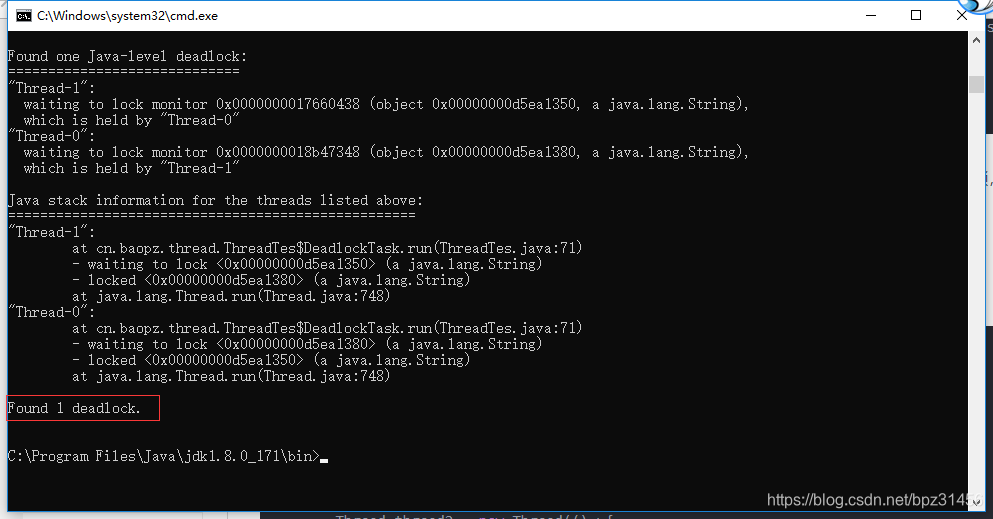线程简介
进程,操作系统中分配资源的基本单元,线程,操作系统中运行的基本单元,在一个进程中可以包含一个或多个线程,进程间通信,资源共享效率低,在同一个进程中,所有线程共享资源。
线程在使用时,也存在各种问题,线程安全性,线程活跃性,线程性能
线程安全性
在多线程环境中,能够正确地处理多个线程之间的共享变量,使程序功能正确完成,这里的正确完成,就是每个线程得到预期值。
示例代码中,thread1和thread2共享资源ArrayList,而ArrayList本身并不是线程安全的容器,在每个线程中都各自取出list中第一个元素加50次,我们期望的值是100,经过运行后,值可能不是100,就存在线程安全性问题
public static void count() {
List<Integer> list = new ArrayList<>();
list.add(0);
Thread thread1 = new Thread(new Task(list));
Thread thread2 = new Thread(new Task(list));
thread1.start();
thread2.start();
try {
thread1.join();
thread2.join();
} catch (InterruptedException e) {
e.printStackTrace();
}
System.out.println(list.get(0));
}
public static class Task implements Runnable {
List<Integer> list;
public Task(List<Integer> list) {
this.list = list;
}
@Override
public void run() {
for (int i = 0; i < 50; i++) {
int value = list.get(0);
list.set(0, ++value);
}
}
}线程活跃性问题
线程活跃性问题,死锁,弱响应性,饥饿,活锁,丢失的信号等
死锁
当两个以上的运算单元,双方都在等待对方停止运行,以获取系统资源,但是没有一方提前退出时,就称为死锁。
死锁实例
public static void deadlock() {
String sourceA = "A";
String sourceB = "B";
Thread thread1 = new Thread(new DeadlockTask(sourceA,sourceB));
Thread thread2 = new Thread(new DeadlockTask(sourceB,sourceA));
thread1.start();
thread2.start();
try {
thread1.join();
thread2.join();
} catch (InterruptedException e) {
e.printStackTrace();
}
}
public static class DeadlockTask implements Runnable{
private String first;
private String sec;
public DeadlockTask(String first,String sec){
this.first = first;
this.sec = sec;
}
@Override
public void run() {
synchronized (first){
System.out.println(Thread.currentThread().getName()+"获取到资源:"+ first);
try {
TimeUnit.SECONDS.sleep(1);
} catch (InterruptedException e) {
e.printStackTrace();
}
synchronized (sec){
System.out.println(Thread.currentThread().getName()+"获取到资源:"+ sec);
}
}
}
}造成死锁有几个因素,禁止抢占、持有和等待、互斥、循环等待,只要打破其中一个条件就不会产生死锁,java中减少在锁嵌套,超时等待获取锁等。
死锁检测手段
1.用 jstack <pid>工具转存stack信息,进行检测

2.用jvisualvm 图形化工具查看

饥饿
在多线程环境中,线程永远轮不到cpu时间片,一直处于等待状态,这个不好演示,也不好检测,以下程序演示了设置线程优先级,避免饥饿就是尽量减少线程优先级设置。
public static void lockHunger(){
Thread thread1 = new Thread(new Runnable(){
@Override
public void run() {
System.out.println("A");
}
});
thread1.setPriority(Thread.MIN_PRIORITY);
Thread thread2 = new Thread(()->{
System.out.println("B");
});
thread2.setPriority(Thread.MAX_PRIORITY);
thread1.start();
thread2.start();
try {
thread1.join();
thread2.join();
} catch (InterruptedException e) {
e.printStackTrace();
}
}弱响应性
cpu大量时间在处理其他任务,而对某些线程调度时间较少,导致响应缓慢,缓解办法,就是把响应较慢的线程优先级设置高些。
活锁
线程并没有阻塞,而是不断重试相同的操作,但是总是失败,一直处于这种尴尬的状态,避免的操作,增加重试次数限制机制。
实例代码中,线程尝试去对状态值经行修改,然后做一次db交互。
private static void livelock() {
final AtomicInteger status = new AtomicInteger();
Thread thread = new Thread(()->{
while(status.getAndAdd(0)==0){
System.out.println("尝试修改状态.");
try {
TimeUnit.SECONDS.sleep(1);
} catch (InterruptedException e) {
e.printStackTrace();
}
}
System.out.println("做一次DB交互,保存状态值。");
},"活锁测试.");
thread.start();
try {
thread.join();
} catch (InterruptedException e) {
e.printStackTrace();
}
}丢失的信号
给线程一个可预期的信号值,然后让这个线程继续下面的,但是没有得到这个信号,导致的问题。
测试实例,thread1设置信号,thread2根据信号执行任务,由于信号线程的执行无法预知,虽然thread1先调用start(),但是很可能thread2得不到预期的值,避免程序,在thread2中while等待,将不会产生这个问题。
private static void lostSemaphore() {
final AtomicBoolean semaphore = new AtomicBoolean();
Thread thread1 = new Thread(() -> {
System.out.println("设置信号量");
semaphore.set(true);
}, "设置信号量。");
Thread thread2 = new Thread(() -> {
if (semaphore.get()) {
System.out.println("继续我的任务。");
}
}, "接受信号量。");
thread1.start();
thread2.start();
try {
thread1.join();
thread2.join();
} catch (InterruptedException e) {
e.printStackTrace();
}
}线程性能
多线程比单线提高了性能,但是也会带来一定开销,当这个开销非常大时,就会出现线程新能问题,具体只对多线程的管理,线程创建,线程调度,线程销毁,上下文切换(线程在运行和阻塞状态相互切换时),自旋等待,内存同步等。
1.采用多线程,是多大限度的让cpu做有用的事情(而不是在上下文切换这种任务消耗),一个任务需要多少线程同时处理才能达到达到最佳性能呢?设置一个非常大的值对不对呢?
这个值需要不断的测试才能得出,在Netty中NioEventLoopGroup中默认值是cup核数*2。
2.阿姆达尔定律(英语:Amdahl's law,Amdahl's argument),一个计算机科学界的经验法则,因吉恩·阿姆达尔而得名。它代表了处理器并行运算之后效率提升的能力。
S=1/(1-a+a/n),a为并行计算部分所占比例,n为并行处理结点个数。这样,当1-a=0时,(即没有串行,只有并行)最大加速比s=n;当a=0时(即只有串行,没有并行),最小加速比s=1;当n→∞时,极限加速比s→ 1/(1-a),这也就是加速比的上限。(阿姆达尔定律)
总结,这章节讲了线程简介,以及线程安全性问题,线程活跃性问题,以及线程性能问题,下一章节讲解线程的状态,线程的创建,线程同步器。